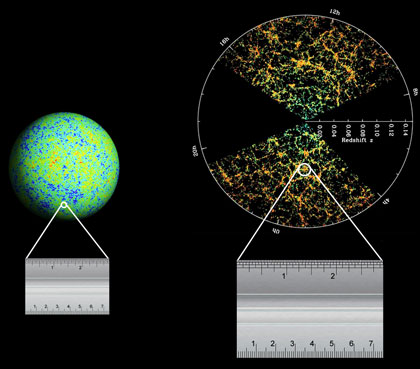
Standard Rulers
Image: The acoustic oscillations in the baryon-photon plasma in the early Universe, at around 380 000 years of age, imprint a charecteristic length scale in the cosmic microwave background and the large-scale structure distribution or matter. This can be used as a standard ruler.
To measure the expansion of the Universe, cosmologists utilize standardized reference objects. One such standard reference is standard rulers. These are objects or features where the actual size of all objects of the same type is the same. By comparing this size to the apparent size of the objects in the sky, we get a measure of how far away the objects are from us. Combined with an estimate of the relative size of the Universe at the time the object sent the light out, we can then map the expansion history of the Universe.
The most prominent use of standard rulers today are the “baryon acoustic oscillations”, overdensities in the distribution of matter in the Universe which occur at regular intervals and therefore provide a standard ruler. These were first measured in 2005 when the Sloan Digital Sky Survey published results from its large survey of galaxies, showing that galaxies are, on average, preferentially found at a distance of about 500 million light years from each other. This standard ruler has its origin in the quantum fluctuations also causing the cosmic microwave background anisotropy, for which the typical fluctuation size (the “acoustic scale”) constitutes another standard ruler.
Although not an entirely new idea, the first use of standard rulers in a cosmological context appears to be due to Carl Wirz in 1924 (without absolute calibration) and Knut Lundmark in 1924-25 (with absolute calibration), who demonstrated a correlation between the angular diameter and distance of galaxies. The ‘standard ruler’ assumption that galaxies of the same type have the same size has been used by numerous other astronomers to determine galaxy distances.
Links
Wikipedia: Baryon acoustic oscillations >
WiggleZ confirms the Big Picture of the Universe >
Select Historical Papers on Cosmology >
Multimedia
The WiggleZ Dark Energy Survey: Confirming the Big Picture of the Universe >

